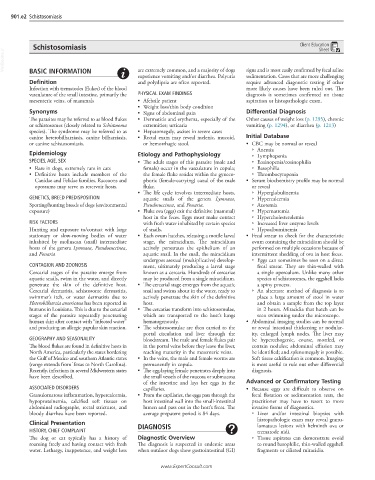Page 1801 - Cote clinical veterinary advisor dogs and cats 4th
P. 1801
901.e2 Schistosomiasis
Schistosomiasis Client Education
Sheet
VetBooks.ir
are extremely common, and a majority of dogs
BASIC INFORMATION
experience vomiting and/or diarrhea. Polyuria signs and is most easily confirmed by fecal saline
sedimentation. Cases that are more challenging
Definition and polydipsia are often reported. require advanced diagnostic testing if other
Infection with trematodes (flukes) of the blood more likely causes have been ruled out. The
vasculature of the small intestine, primarily the PHYSICAL EXAM FINDINGS diagnosis is sometimes confirmed on tissue
mesenteric veins, of mammals • Afebrile patient aspiration or histopathologic exam.
• Weight loss/thin body condition
Synonyms • Signs of abdominal pain Differential Diagnosis
The parasites may be referred to as blood flukes • Dermatitis and erythema, especially of the Other causes of weight loss (p. 1295), chronic
or schistosomes (closely related to Schistosoma extremities; urticaria vomiting (p. 1294), or diarrhea (p. 1213)
species). The syndrome may be referred to as • Hepatomegaly, ascites in severe cases
canine heterobilharziasis, canine bilharziasis, • Rectal exam may reveal melenic, mucoid, Initial Database
or canine schistosomiasis. or hemorrhagic stool. • CBC may be normal or reveal
○ Anemia
Epidemiology Etiology and Pathophysiology ○ Lymphopenia
SPECIES, AGE, SEX • The adult stages of this parasite (male and ○ Eosinopenia/eosinophilia
• Rare in dogs, extremely rare in cats female) occur in the vasculature in copula; ○ Basophilia
• Definitive hosts include members of the the female fluke resides within the gyneco- ○ Thrombocytopenia
Canidae and Felidae families. Raccoons and phoric (female-carrying) canal of the male • Serum biochemistry profile may be normal
opossums may serve as reservoir hosts. fluke. or reveal
• The life cycle involves intermediate hosts, ○ Hyperglobulinemia
GENETICS, BREED PREDISPOSITION aquatic snails of the genera Lymnaea, ○ Hypercalcemia
Sporting/hunting breeds of dogs (environmental Pseudosuccinea, and Fossaria. ○ Azotemia
exposure) • Fluke ova (eggs) exit the definitive (mammal) ○ Hypernatremia
host in the feces. Eggs must make contact ○ Hypercholesterolemia
RISK FACTORS with fresh water inhabited by certain species ○ Increased liver enzyme levels
Hunting and exposure to/contact with large of snails. ○ Hypoalbuminemia
stationary or slow-moving bodies of water • Each ovum hatches, releasing a motile larval • Fecal smear to check for the characteristic
inhabited by molluscan (snail) intermediate stage, the miracidium. The miracidium ovum containing the miracidium should be
hosts of the genera Lymnaea, Pseudosuccinea, actively penetrates the epithelium of an performed on multiple occasions because of
and Fossaria aquatic snail. In the snail, the miracidium intermittent shedding of ova in host feces.
undergoes asexual (multiplicative) develop- ○ Eggs can sometimes be seen on a direct
CONTAGION AND ZOONOSIS ment, ultimately producing a larval stage fecal smear. They are thin-walled with
Cercarial stages of the parasite emerge from known as a cercaria. Hundreds of cercariae a single operculum. Unlike many other
aquatic snails, swim in the water, and directly may be produced from a single miracidium. species of schistosomes, the eggshell lacks
penetrate the skin of the definitive host. • The cercarial stage emerges from the aquatic a spiny process.
Cercarial dermatitis, schistosome dermatitis, snail and swims about in the water, ready to ○ An alternate method of diagnosis is to
swimmer’s itch, or water dermatitis due to actively penetrate the skin of the definitive place a large amount of stool in water
Heterobilharzia americana has been reported in host. and obtain a sample from the top layer
humans in Louisiana. This is due to the cercarial • The cercariae transform into schistosomulae, in 2 hours. Miracidia that hatch can be
stages of the parasite repeatedly penetrating which are transported to the host’s lungs seen swimming under the microscope.
human skin after contact with “infected water” hematogenously. • Abdominal imaging studies can be normal
and producing an allergic papular skin reaction. • The schistosomulae are then carried to the or reveal intestinal thickening or nodular-
portal circulation and liver through the ity, enlarged lymph nodes. The liver may
GEOGRAPHY AND SEASONALITY bloodstream. The male and female flukes pair be hyperechogenic, course, mottled, or
The blood flukes are found in definitive hosts in in the portal veins before they leave the liver, contain nodules; abdominal effusion may
North America, particularly the states bordering reaching maturity in the mesenteric veins. be identified; and splenomegaly is possible.
the Gulf of Mexico and southern Atlantic states • In the veins, the male and female worms are Soft tissue calcification is common. Imaging
(range extends from Texas to North Carolina). permanently in copula. is most useful to rule out other differential
Recently, infections in several Midwestern states • The egg-laying female penetrates deeply into diagnosis.
have been described. the small vessels of the mucosa or submucosa
of the intestine and lays her eggs in the Advanced or Confirmatory Testing
ASSOCIATED DISORDERS capillaries. • Because eggs are difficult to observe on
Granulomatous inflammation, hypercalcemia, • From the capillaries, the eggs pass through the fecal flotation or sedimentation tests, the
hypoproteinemia, calcified soft tissues on host intestinal wall into the small-intestinal practitioner may have to resort to more
abdominal radiographs, rectal strictures, and lumen and pass out in the host’s feces. The invasive forms of diagnostics.
bloody diarrhea have been reported. average prepatent period is 84 days. ○ Liver and/or intestinal biopsies with
histopathologic exam may reveal granu-
Clinical Presentation lomatous lesions with helminth ova or
HISTORY, CHIEF COMPLAINT DIAGNOSIS trematode nidi.
The dog or cat typically has a history of Diagnostic Overview ○ Tissue aspirates can demonstrate ovoid
roaming freely and having contact with fresh The diagnosis is suspected in endemic areas to round basophilic, thin-walled eggshell
water. Lethargy, inappetence, and weight loss when outdoor dogs show gastrointestinal (GI) fragments or ciliated miracidia.
www.ExpertConsult.com

